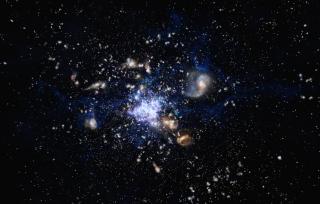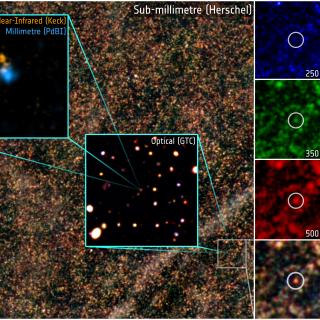Bibcode
Bakx, Tom J. L. C.; Berta, S.; Dannerbauer, H.; Cox, P.; Butler, K. M.; Hagimoto, M.; Hughes, D. H.; Riechers, D. A.; van der Werf, P. P.; Yang, C.; Baker, A. J.; Beelen, A.; Bendo, G. J.; Borsato, E.; Buat, V.; Cooray, A. R.; Dunne, L.; Dye, S.; Eales, S.; Gavazzi, R.; Harris, A. I.; Ismail, D.; Ivison, R. J.; Jones, B.; Krips, M.; Lehnert, M. D.; Marchetti, L.; Messias, H.; Negrello, M.; Neri, R.; Omont, A.; Perez-Fournon, I.; Nanni, A.; Chartab, N.; Serjeant, S.; Stanley, F.; Tamura, Y.; Urquhart, S. A.; Vlahakis, C.; Weiß, A.; Young, A. J.
Bibliographical reference
Monthly Notices of the Royal Astronomical Society
Advertised on:
6
2024
Citations
5
Refereed citations
3
Description
We report on deep SCUBA-2 observations at 850 $\mu$m and NOrthern Extended Millimetre Array (NOEMA) spectroscopic measurements at 2 mm of the environment surrounding the luminous, massive (M* ≈ 2 × 1011 M⊙) Herschel-selected source HerBS-70. This source was revealed by previous NOEMA observations to be a binary system of dusty star-forming galaxies at z = 2.3, with the east component (HerBS-70E) hosting an active galactic nucleus. The SCUBA-2 observations detected, in addition to the binary system, 21 sources at >3.5σ over an area of ~25 square comoving Mpc with a sensitivity of 1σ850 = 0.75 mJy. The surface density of continuum sources around HerBS-70 is three times higher than for field galaxies. The NOEMA spectroscopic measurements confirm the protocluster membership of three of the nine brightest sources through their CO(4-3) line emission, yielding a volume density 36 times higher than for field galaxies. All five confirmed sub-mm galaxies in the HerBS-70 system have relatively short gas depletion times (80-500 Myr), indicating the onset of quenching for this protocluster core due to the depletion of gas. The dark matter halo mass of the HerBS-70 system is estimated around 5 × 1013 M⊙, with a projected current-day mass of 1015 M⊙, similar to the local Virgo and Coma clusters. These observations support the claim that DSFGs, in particular the ones with observed multiplicity, can trace cosmic overdensities.
Related projects

Molecular Gas and Dust in Galaxies Across Cosmic Time
Two of the most fundamental questions in astrophysics are the conversion of molecular gas into stars and how this physical process is a function of environments on all scales, ranging from planetary systems, stellar clusters, galaxies to galaxy clusters. The main goal of this internal project is to get insight into the formation and evolution of
Helmut
Dannerbauer

Formation and Evolution of Galaxies: Observations in Infrared and other Wavelengths
This IAC research group carries out several extragalactic projects in different spectral ranges, using space as well as ground-based telescopes, to study the cosmological evolution of galaxies and the origin of nuclear activity in active galaxies. The group is a member of the international consortium which built the SPIRE instrument for the
Ismael
Pérez Fournon